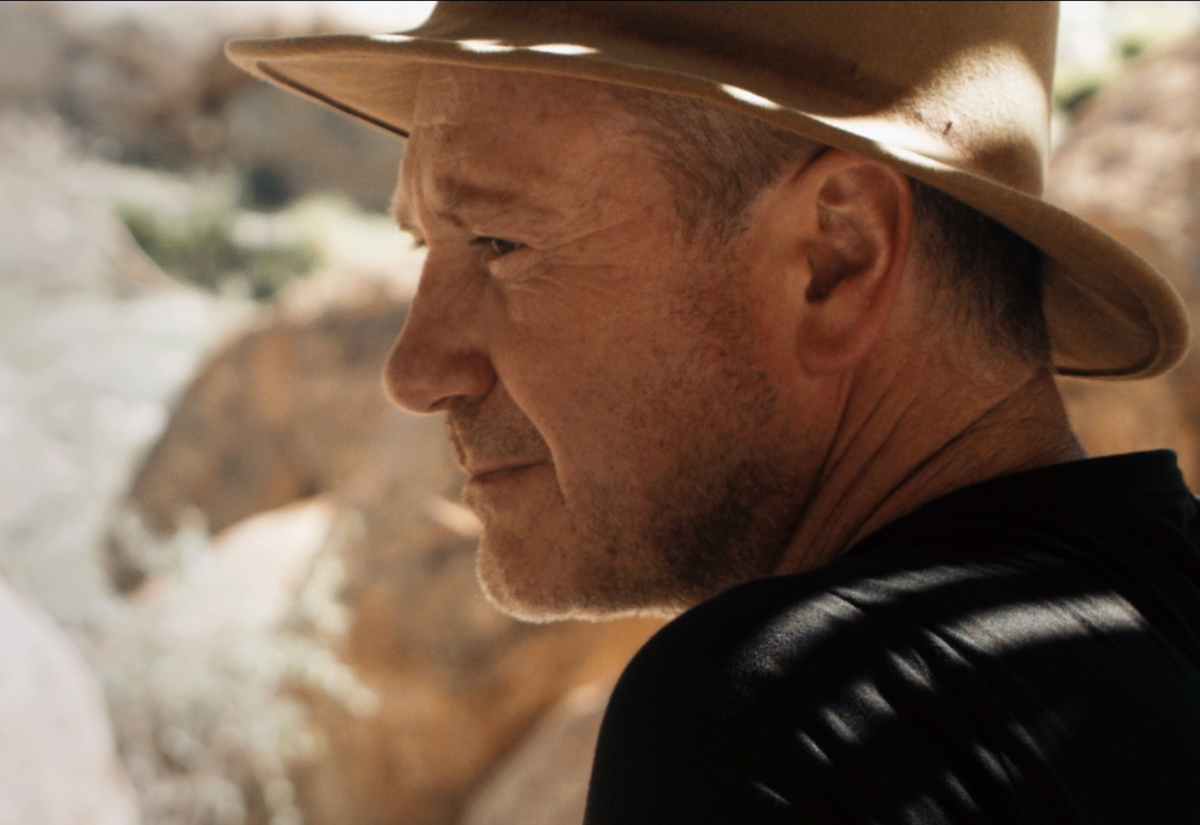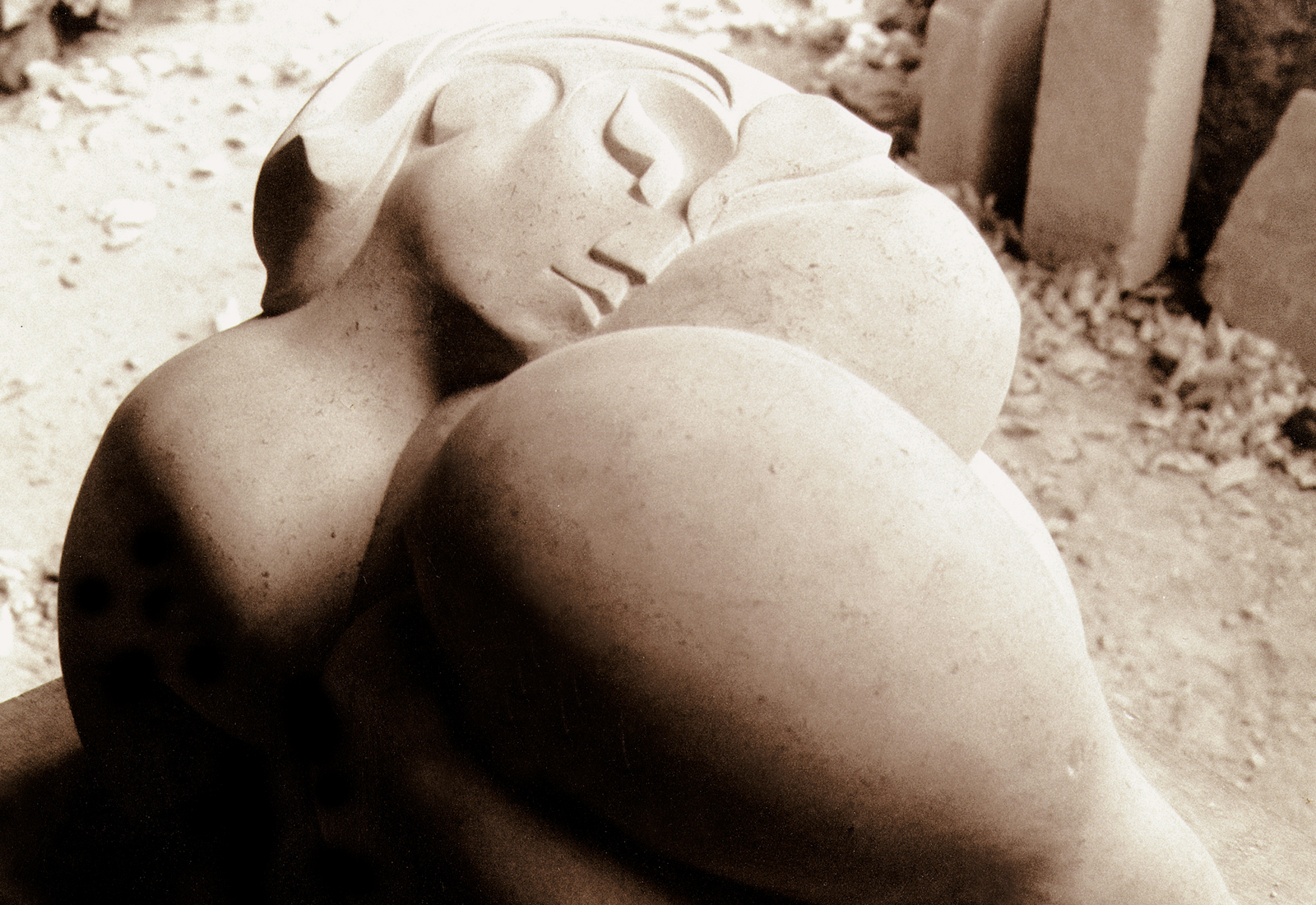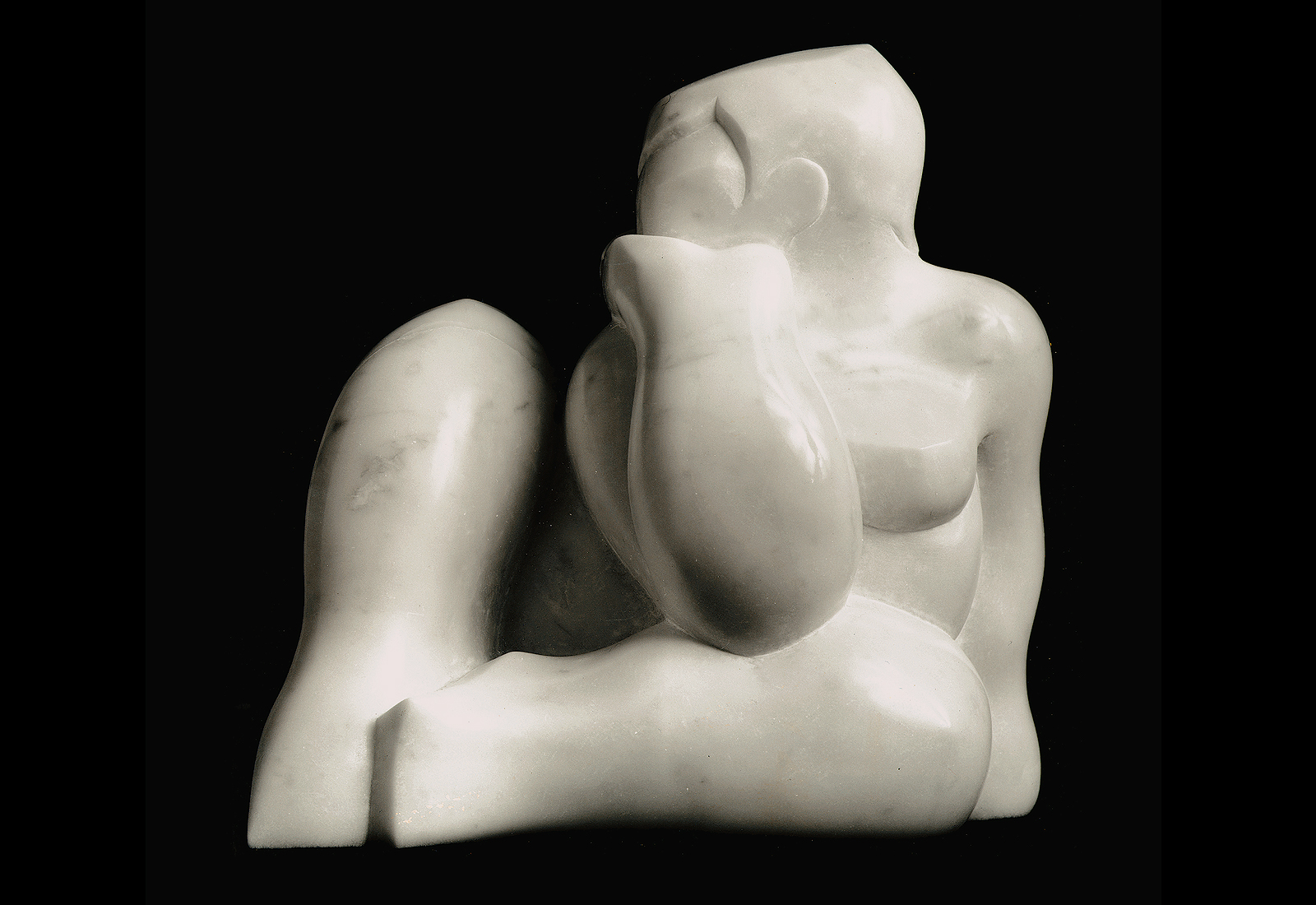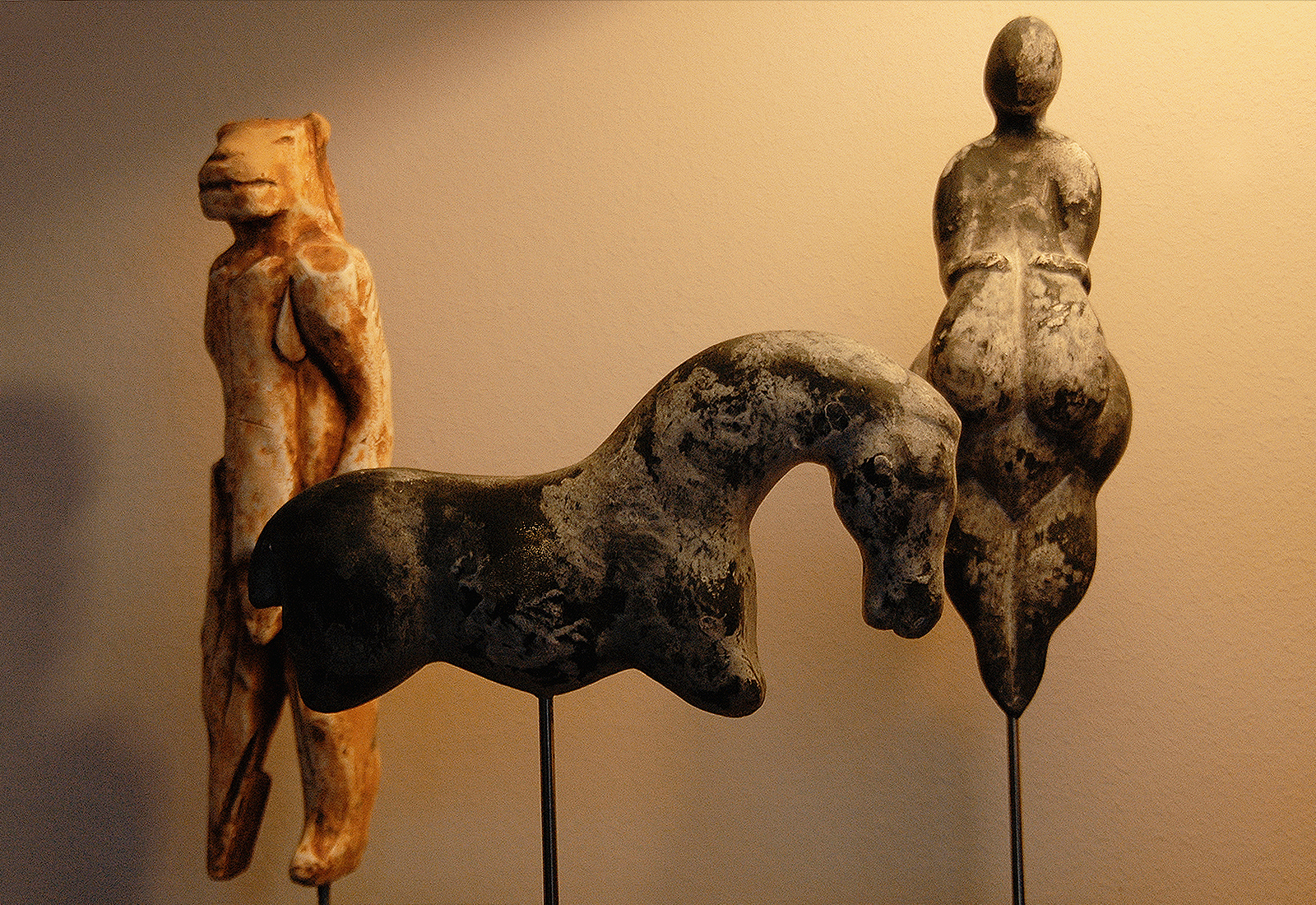
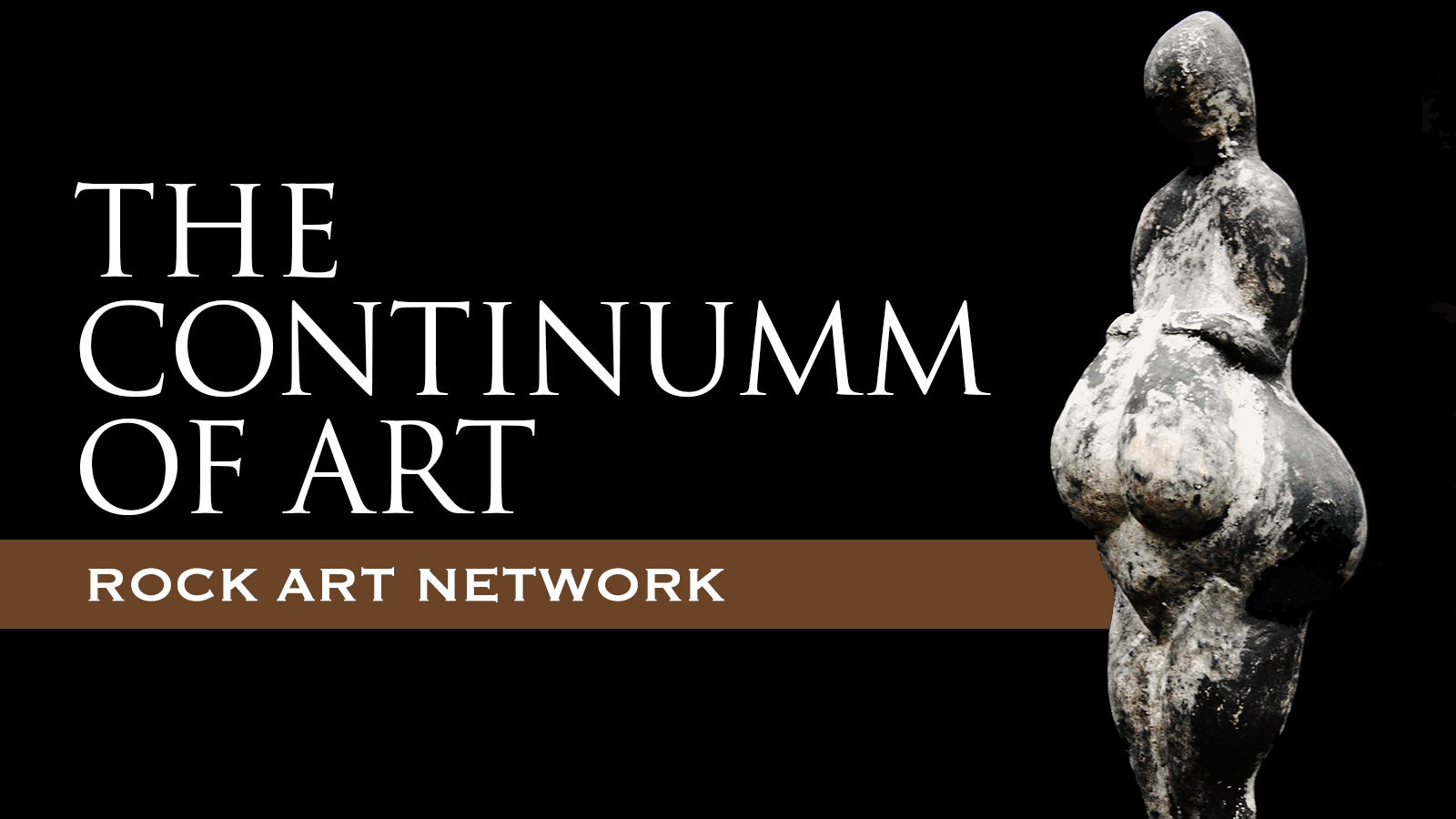
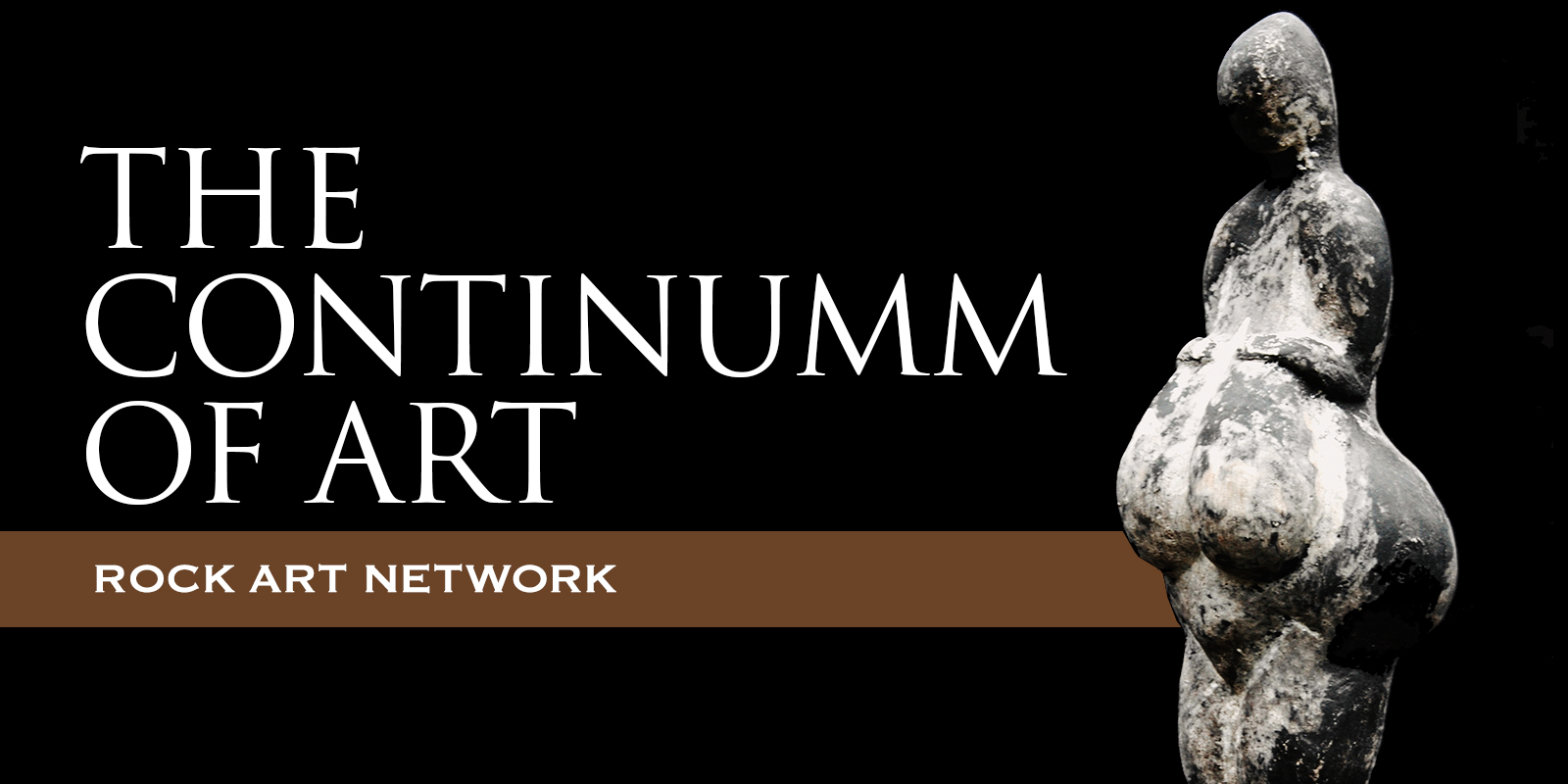
by Peter Robinson
Editor, Bradshaw Foundation
I believe this applies to the study of rock art; for me, walking into a deep cave to be confronted by an ancient painting will always summon the ancestors. Or, to put it more accurately, summon the original artist. Studying rock art is not just a mechanical process, but an emotional one as well. I am speaking as an artist, not an archaeologist.
By considering the connection between prehistoric art and contemporary art, I want to introduce the concept of the vein of art.
Chronologically, artists have tended to be inspired by a preceding vein of art or art movement. It is a reaction to what has gone before; either building on it or dismissing it altogether.
But for the prehistoric artist, there were no precedents, no vein of art to follow. Yes, there were artistic traditions – long ones – but what was the source of inspiration? What was the initial spark? In Robert Macfarlane’s book ‘Underland’, whilst referring to the art of Chauvet, he quotes John Berger: 'Art is born like a foal that can walk straight away……the talent to make art accompanies the need for that art; they arrive together.'
Does this apply on a global scale to all prehistoric rock art? Did all art begin in the same way?
One way to approach this complex area is to consider the artistic route taken. Palaeolithic art offers the first visible sign of modern human consciousness, of self-awareness, with the use of metaphor and symbol, as well as a sense of beauty.
Is this human instinct, or is it a matter for neuroscientists who are concerned with the human visual cortex? Neuroscientists analyze recurrent geometric motifs in rock art in relation to the anatomical and neurophysiologic characteristics of the human visual cortex, displaying the 'universality' hypothesis and the concept of 'neuro-aesthetics'.
Another way of looking at this; the author Yuval Harari in his book ‘Sapiens’ asks whether it is ‘algorithms or soul music?’ Perhaps with the life sciences, art is not the product of enchanted spirit or metaphysical soul, but rather the product of organic algorithms recognizing mathematical patterns.
Rather than take sides, this leads me to the point that the human artistic experience should make us begin to think about the purpose of rock art. Something happened – on a global scale – which enabled the prehistoric artist to visualize the result of artistic work in advance, based on an outstanding sense of aesthetic perception. This tendency has been apparent in art ever since. It appears to be something as a species we cannot escape from. Very early in the development of technology, something astonishing happened. Axe heads took on features that were not purely practical. Axe heads became objects of beauty. Where did function end and aesthetics begin in the earliest human cultures? In fact, these hand axes provide the earliest evidence of humans with a brain capable of externalizing thought; they were objects which carried messages from, between and about their makers.
In search of a purpose, a possible understanding might be gained through a concept that I, as an artist, learnt from a friend, as an archaeologist – liminal. This concept traverses time; it represents an experience that occupies a position at, or on both sides of, a boundary. Earlier I referred to the shared human experience of the archaeologist. Now I want to apply that to the world to art. I believe a contemporary artist can use his or her own experience of being a human and an artist to gain an understanding of art in a Palaeolithic world.
This is an atavistic stance, whereby something ancient or ancestral, in artistic terms, can be [subconsciously] understood. A direct connection is somehow made. It is impossible for me to quantify, and I am basing my observations on personal experience, yet it has revealed to me unexpected artistic insights into the world of our creative ancestors.
My first experience of this phenomenon came from a commission to carve a sculpture based on the Lions of Soleb, or the Prudhoe Lions, dated 1370 BC in the British Museum. As I began to study this early Egyptian sculpture, I realized that the stylistic lines and shapes were remarkably similar to those of my own work. Much of the granite lion had been damaged over time – it had after all belonged to Amenhotep III and Tutankhamun - but as my work began, I felt I was able to return to what was originally intended by the original sculptor. Or something very close to it.
Perhaps this was endorsed by a painting I came across, having completed my sculpture, by Sir John Edward Poynter entitled ‘Israel in Egypt’ painted in 1867. He too would have studied the battered yet magnificent Lion of Soleb, but there we are reaching the same destination. Three artists were now connected.
So what does this have to do with rock art? I will endeavor to explain by sharing my second liminal experience with my own figurine sculptures. My style is ‘expressionist’ and this vein of art was initiated long before my involvement with the Bradshaw Foundation. Only now can I recognize the connection to the Ice Age figurines. My sculptures attempt to capture the feminine spirit. The sculptures correspond to a classical style, but the clear reduction to essentials represents my quest for 'origin'.
The emotional pitch is produced by the omissions, distortions and exaggerations. The subject is intensified by its inner attributes at the expense of its outer attributes.
The whole is resolved in a harmony that belies the distortion of the parts. The effect, I hope, is 'absoluteness' - the sculpture does not speak beyond herself. She is self-contained. I could be speaking about any one of the Ice Age figurines.
As if that wasn’t enough proof for me, I was then commissioned by Jill Cook of the British Museum for her exhibition ‘Ice Age Art: arrival of the modern mind’ to create sculpture maquettes that celebrated the Ice Age art. At the time, I considered this to be commercial art rather than fine art and I chose the three stars [for me] from the exhibition – the Lion Man, the Lespugue figurine and the Vogelherd horse.
It was only once I got to work in the studio that I realized this was not commercial art at all. In fact, it was an extraordinary privilege to be working on these pieces, allowing a deep level of artistic communication.
I came away with 2 things; an understanding of ‘how’, and a realization of ‘process not product’. Perhaps I came away with an understanding of ‘why’, but that would be mere speculation.
For the ‘how’, I work by profile; a sculptural form is made up of countless profiles, each one leading to the next, with the final profile eventually meeting the first profile. By working this way on the Ice Age figures, I was able to gain an understanding of how the original artist had achieved the 3-dimensional form. For example, with the Lespugue figurine, I was able to see and feel how the original artist had connected an intricate series of geometric volumes, with convex shelves disappearing into concave ravines, whilst emphasizing the meaningful aspects of the woman’s body in an aesthetic form which reflected on the origins and nourishment of life.
For the ‘process not product’, as I worked, fully aware of the Palaeolithic artist beside me working on something very similar, I began to think of the Ice Age sculptures that archaeologists believe were deliberately broken and buried. Why would you do that? Likewise, why was there a great tendency in cave paintings and pictographs to create palimpsests by over-painting? Was the process far more important than the final product? In Cussac cave in France, researchers now believe that the engravings were created for an audience, as a performance. Perhaps art was an action instead of a final visual; a moment in time with no return. Personally, I find working on the sculpture far more satisfying than the finished piece.
I recently attended a lecture given by Sir Martin Rees, the Astronomer Royal, former head of the Royal Society, Master of Trinity College and Emeritus Professor of Cosmology and Astrophysics at the University of Cambridge, a former Trustee of London’s British Museum and the Science Museum, and a member of the House of Lords. His highly engaging talk on future scientific research ended on the need to focus on what is important and what is relevant. I was shocked to hear him say “…for example, dinosaurs are irrelevant – there are none.” But this made me realize - rock art is relevant, because it exists, it is still being practiced, and it is a vital form of communication. That is why it deserves attention and requires protection.
There is life in rock art yet, on many levels. I believe the connection between rock art and contemporary art is just one. Rock art must not be seen as anachronistic and irrelevant. It is everywhere and it is a part of everyone’s story. Rock art researchers often claim that rock art has been neglected by archaeologists and art historians. That has certainly changed in recent years. But for historical and contemporary artists, rock art has never been neglected, and its relevance and inspiration has always been revered.
→ Members and affiliated institutions of the Rock Art Network
by
George Nash
5/09/2024 Recent Articles
→ Sigubudu: Paintings of people with guns in the northern uKhahlamba-Drakensberg
by Aron Mazel
22/07/2024
by Richard Kuba
13/06/2024
by Meenakshi Dubey-Pathak
8/03/2024
by Rock Art Network
6/02/2024
by Rock Art Network
14/12/2023
by Sam Challis
5/12/2023
by Aron Mazel
30/11/2023
by Sam Challis
21/11/2023
by Sam Challis
15/11/2023
by Sam Challis
10/11/2023
by Rock Art Network
6/11/2023
by Rock Art Network
3/11/2023
by Aron Mazel
2/11/2023
by Meenakshi Dubey-Pathak
26/09/2023
by Paul Taçon
24/08/2023
by Aron Mazel
13/06/2023
by Paul Taçon
5/06/2023
by Paul Taçon
15/03/2023
by George Nash
14/03/2023
by Noel Hidalgo Tan
10/02/2023
by George Nash
01/02/2023
by Meenakshi Dubey-Pathak, Pilar Fatás Monforte
29/11/2022
by Aron Mazel, George Nash
21/09/2022
by Paul S.C. Taçon, Sally K. May, Ursula K. Frederick, Jo McDonald
07/07/2022
by Meenakshi Dubey-Pathak
26/07/2022
by Paul Taçon
20/07/2022
by David Coulson
16 June 2022
by Paul Taçon
25 April 2022
by Noel Hidalgo Tan
20 April 2022
by Meenakshi Dubey-Pathak
14 March 2022
by Carolyn Boyd & Pilar Fatás
02 March 2022
by David Coulson
07 February 2022
by Johannes H. N. Loubser
06 February 2022
by Meenakshi Dubey-Pathak
05 February 2022
by Aron Mazel
28 January 2022
by Aron Mazel
8 September 2021
by David Coulson
17 August 2021
by Ffion Reynolds
21 June 2021


by Aron Mazel
22/07/2024
by Richard Kuba
13/06/2024
by Meenakshi Dubey-Pathak
8/03/2024
by Rock Art Network
6/02/2024
by Rock Art Network
14/12/2023
by Sam Challis
5/12/2023
by Aron Mazel
30/11/2023
by Sam Challis
21/11/2023
by Sam Challis
15/11/2023
by Sam Challis
10/11/2023
by Rock Art Network
6/11/2023
by Rock Art Network
3/11/2023
by Aron Mazel
2/11/2023
by Meenakshi Dubey-Pathak
26/09/2023
by Paul Taçon
24/08/2023
by Aron Mazel
13/06/2023
by Paul Taçon
5/06/2023
by Paul Taçon
15/03/2023
by George Nash
14/03/2023
by Noel Hidalgo Tan
10/02/2023
by George Nash
01/02/2023
by Meenakshi Dubey-Pathak, Pilar Fatás Monforte
29/11/2022
by Aron Mazel, George Nash
21/09/2022
by Paul S.C. Taçon, Sally K. May, Ursula K. Frederick, Jo McDonald
07/07/2022
by Meenakshi Dubey-Pathak
26/07/2022
by Paul Taçon
20/07/2022
by David Coulson
16 June 2022
by Paul Taçon
25 April 2022
by Noel Hidalgo Tan
20 April 2022
by Meenakshi Dubey-Pathak
14 March 2022
by Carolyn Boyd & Pilar Fatás
02 March 2022
by David Coulson
07 February 2022
by Johannes H. N. Loubser
06 February 2022
by Meenakshi Dubey-Pathak
05 February 2022
by Aron Mazel
28 January 2022
by Aron Mazel
8 September 2021
by David Coulson
17 August 2021
by Ffion Reynolds
21 June 2021
Friend of the Foundation


by Aron Mazel
22/07/2024
by Richard Kuba
13/06/2024
by Meenakshi Dubey-Pathak
8/03/2024
by Rock Art Network
6/02/2024
by Rock Art Network
14/12/2023
by Sam Challis
5/12/2023
by Aron Mazel
30/11/2023
by Sam Challis
21/11/2023
by Sam Challis
15/11/2023
by Sam Challis
10/11/2023
by Rock Art Network
6/11/2023
by Rock Art Network
3/11/2023
by Aron Mazel
2/11/2023
by Meenakshi Dubey-Pathak
26/09/2023
by Paul Taçon
24/08/2023
by Aron Mazel
13/06/2023
by Paul Taçon
5/06/2023
by Paul Taçon
15/03/2023
by George Nash
14/03/2023
by Noel Hidalgo Tan
10/02/2023
by George Nash
01/02/2023
by Meenakshi Dubey-Pathak, Pilar Fatás Monforte
29/11/2022
by Aron Mazel, George Nash
21/09/2022
by Paul S.C. Taçon, Sally K. May, Ursula K. Frederick, Jo McDonald
07/07/2022
by Meenakshi Dubey-Pathak
26/07/2022
by Paul Taçon
20/07/2022
by David Coulson
16 June 2022
by Paul Taçon
25 April 2022
by Noel Hidalgo Tan
20 April 2022
by Meenakshi Dubey-Pathak
14 March 2022
by Carolyn Boyd & Pilar Fatás
02 March 2022
by David Coulson
07 February 2022
by Johannes H. N. Loubser
06 February 2022
by Meenakshi Dubey-Pathak
05 February 2022
by Aron Mazel
28 January 2022
by Aron Mazel
8 September 2021
by David Coulson
17 August 2021
by Ffion Reynolds
21 June 2021
Friend of the Foundation
